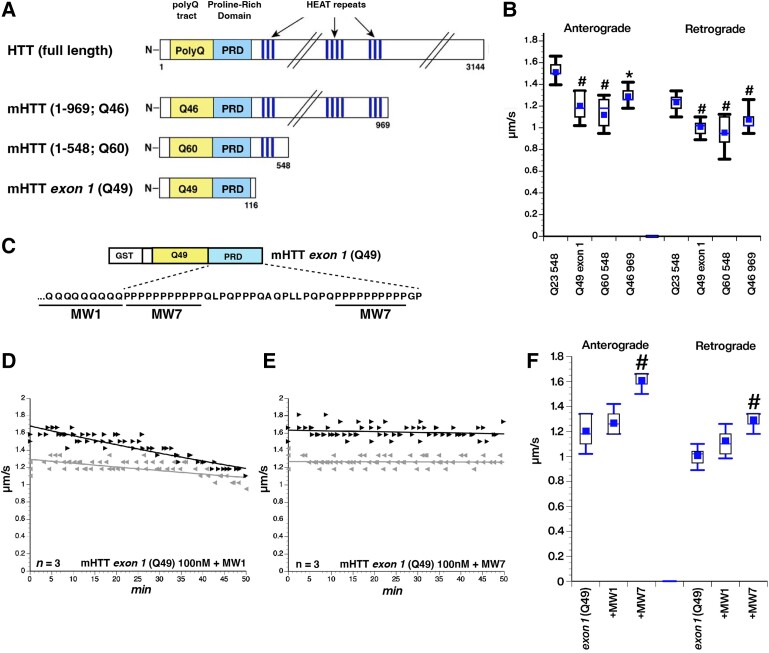Figure 1.
Toxicity of huntingtin fragments on fast axonal transport. (A) Huntingtin (HTT) is a protein of unknown function containing more than 3000 amino acids. The absence of an identified catalytic activity suggests a role for HTT as a scaffold for unknown cellular components. While previous studies have determined that exon 1 is sufficient for neurotoxicity, HTT contains multiple potential protein interaction domains [e.g. polyQ tract, a proline-rich domain (PRD) and HEAT repeats], which could provide additional biological activities. Three different recombinant mHTT fragments ranging from approximately 100 to 1000 amino acids were generated to determine whether different mHTT fragments exhibit different toxicities on fast axonal transport in the isolated axoplasm model. (B) All three mutant HTT (mHTT) constructs perfused at 100 nM have the same inhibitory effect on both anterograde and retrograde fast axonal transport rates. #P < 0.0001; *P < 0.001. (C) Exon 1 of mHTT appears to contain the toxic element causing the inhibitory effect in axons. There are two major motifs in exon 1: the expanded polyQ tract and a PRD. Previous studies generated monoclonal antibodies (Abs) to polyQ (MW1) and to polyP (MW7). (D and E) Plots depicting results from vesicle motility assays in isolated squid axoplasm. mHTT exon 1 (49Q) was perfused into axoplasm (100 nM) and fast axonal transport rates monitored by video microscopy, as in B. Individual rate measurements (µm/s, arrowheads) are plotted as a function of time (min). Both anterograde (black arrowheads and lines) and retrograde (reverse grey arrowheads and lines) fast axonal transport rates are shown. (D) Preincubation of mHTT exon 1 (49Q) with MW1 Ab (polyQ-directed) did not alter the toxic effects of this protein, so both anterograde and retrograde transport were still inhibited. n = number of axoplasms evaluated. (E) In contrast, preincubation with MW7 (polyP directed) completely blocked the effects of HTT exon 1 (Q49) on axonal transport. This suggests that exposure and/or accessibility of the PRD is essential for mHTT toxicity on fast axonal transport. (F) Box plots show that preincubation with M1 Ab did not significantly alter the toxic effects of mHTT exon 1 (Q49) on either anterograde or retrograde fast axonal transport. In contrast, preincubation with MW7 significantly reduced such effects. #P < 0.0001.

